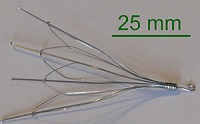
However, the report also acknowledges a major flaw in how the small, cone-shaped, cage-like devices are used. Medical professionals suggest removing an IVC filter two to three months after it has been implanted. The FDA suggests an even quicker timetable for removal of between 29 and 54 days. Both of these recommendation assume the risk of pulmonary embolism has passed.
But setting a follow-up appointment is neither common practice nor required by law. The same doctor who recommends an IVC filter for a patient may not even be the one who implants it creating even more confusion in the follow-up planning. Because of this, Doctor John R. Bartholomew, Section Head of Vascular Medicine at the Cleveland Clinic, “understands how easy it is for patients to get lost” in the process. Currently, less than a third of implanted IVC filters are ever retrieved.
Doctor Bartholomew also says most of his peers “feel there is a benefit” to using IVC filters. But in randomized trials, no mortality benefit has been established for their use. In fact, the cohort’s study shows that pulmonary embolism hospitalization has declined regardless of whether patients have had one of the devices implanted.
IVC filters are designed to prevent blood clots from traveling to vital organs from the lower body. Studies have shown that neglecting to schedule their removal could potentially contribute to the device perforating a patient’s vena cava vein, becoming dislodged, or migrating to another part of the body. As a result, patients and their families can be left to incur steep medical expenses while suffering extreme pain, disability, or even death.
IVC filters from certain manufacturers seem to pose more risks than others. The first bellwether trial of more than 650 suits against Cook Medical Group for its ‘Celect’ model is set to start later this year. The ‘Celect’ has been shown to have a 43% chance of perforating a patient’s vena cava vein within two months of implantation.
An NBC News investigation linked Bard Medical’s ‘Recovery’ IVC filter to 27 deaths. NBC obtained documents that revealed the company knew its product had “higher rates of relative risk for death, filter fracture, and movement than all its competitors.” After they learned this information, Bard waited ten months and sold an estimated 34,000 additional units before finally removing the Recovery model from the market. They replaced it with the G2 model, which was supposed to be safer, but within mere months of FDA approval it was found to have similar issues. The G2 model has since been linked to 12 deaths.
Lopez McHugh represents hundreds of people across the country who claim to have been injured or have a family member that has been killed or injured by complications related to IVC filters. We hope to send manufacturers the loud-and-clear message that putting profit above patient safety is unethical and will not be tolerated. Our clients will not stand idly by while they and their loved ones are put in life-threatening danger.
